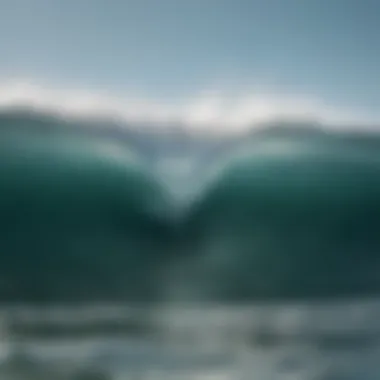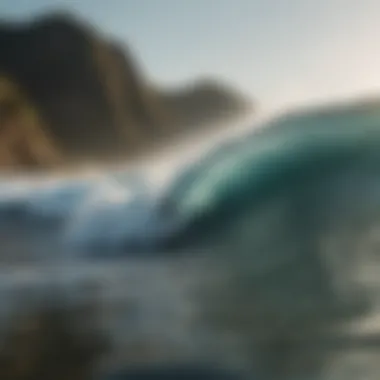Exploring the Depths of 'Swash': Meaning and Impact


Intro
The term 'swash' carries a weight that extends beyond its literal meaning. In various contexts, it reflects a range of ideas, from maritime vocabulary to the vibrant subculture of surfing. Investigating this word opens a door to understanding not just the action of water meeting land but also the lifestyle and values ingrained in coastal communities. The layering of its meanings offers insights into a world where nature and culture intersect.
To grasp what 'swash' truly encapsulates, one might need to step onto the surf or the shoreline, where water's pathway shapes experiences and identities. The interplay of tides guides not just waves but also the rhythm of life among surfers and beach enthusiasts, fostering a connection between humans and the ocean that is often profound.
As we venture through the meaning and significance of 'swash', we’ll cover several aspects: its etymology, nuances in various contexts, and its cultural resonance within surfing communities. This exploration serves to illustrate how 'swash' reflects the essence of coastal life, celebrating the powerful relationship between the ocean and those who seek its embrace.
Prologue to Swash
Understanding the term "swash" is crucial for anyone engaging with the ocean, whether it's surfers, environmentalists, or even casual beachgoers. It embodies not only a physical phenomenon but also a cultural essence deeply embedded in maritime traditions. By grasping the meaning of swash, individuals can dive deeper into the ocean's narrative, unraveling the relationship between water and shore, and recognizing the impact of waves on coastal ecosystems.
Moreover, swash serves as a portal into various facets of life by the sea. It connects to navigation practices in maritime contexts and reflects a broader lifestyle associated with surfing and coastal living. The term transcends its simple definition and resonates with the rhythms of the ocean, evoking a sense of belonging for those who find solace and joy in the surf.
Defining Swash
Swash refers to the turbulent movement of water that pushes up the beach after a wave breaks. This phenomenon occurs as waves crash onto the shore, sending water coursing over the sand, leaving behind foam and tiny ripples. As the tide recedes, this water is carried back to the sea. This unique interplay is a fundamental aspect of coastal dynamics and can be observed practically anywhere there are waves.
It’s important to note that swash is distinct from undertow, which refers to the pull of water back into the ocean. Instead, swash embodies the rush and retreat of water, shaping the sands and wildlife. This phenomenon is not just a spectacle; it plays a vital role in sediment transport and the health of beach ecosystems. Understanding swash offers insights into the complexities of beach environments, algae growth, and even the survival tactics of shoreline species.
Historical Context
The concept of swash has historical roots that can be traced back to early navigation techniques and coastal living. Ancient mariners relied on observing wave patterns and the behavior of swash to safely maneuver their vessels, making it essential for trade and travel. As societies evolved, so did the understanding and significance of swash in maritime communities.
Literature and art have captured the essence of swash, showcasing its vital role in coastal life. Sailors’ tales, beach lore, and artistic representations often illustrate this dynamic force of nature, reflecting cultural connections to the sea. In many cultures, swash symbolizes both the beauty and peril of the ocean, a reminder of nature's unpredictable rhythms.
Overall, the historical significance of swash is as intricate as the ocean itself, intertwining human experiences with the ever-changing tides.
Etymology of Swash
Understanding the etymology of the term swash is essential for grasping its multifaceted meaning. The roots of this word shed light on its various applications, not just in maritime contexts but also in cultural landscapes like surfing. Digging into its linguistic origins serves as a foundation for appreciating the historical and functional dimensions of the concept. One can start to see how its evolution reflects changes in social attitudes, environmental perceptions, and recreational practices.
Origins and Linguistics
The word swash traces its lineage back to Middle English, deriving from the verb swashen, meaning to splash or to wash. This connotation has remained integral to the term's usage today. In maritime parlance, it refers to the movement of water as waves crash upon the shore, a vivid image that embodies action and fluidity. Its Latin roots can be linked to sudare, which means to sweat, hinting at the lively, sometimes chaotic nature of water in motion.
Delving into its linguistic evolution reveals that swash has maintained a consistent relationship with water throughout the ages. Its transformations from Old English to present-day vernacular illustrate not only linguistic shifts but also changing perceptions of those who engage with the sea. The concept has sprouted branches, influencing colloquial expressions and idioms that color everyday language. For instance, saying someone is "in the swash" might evoke images of leisure, beachside enjoyment, or dynamic activities on the waves.
Evolution of Meaning
Over time, swash has broadened its meaning beyond simply referring to physical splashes of water. In modern contexts, it encapsulates notions of adventure, freedom, and connection to nature. As surfing emerged as a global phenomenon, the term was adopted by the surf culture to represent not only the literal action of waves but also the lifestyle that accompanies riding those waves. Surfers often describe the experience of catching a wave as feeling the swash of the ocean beneath them—this is more than physics; it’s an emotional resonance.
The transition of meaning is noteworthy. While originally rooted in describing a physical phenomenon, it has come to symbolize a way of life. Surfers view the ocean as both a playground and a classroom, learning from the waves while respecting their power. This duality encapsulates a broader ecological awareness that is increasingly important as environmental concerns rise.


"To understand swash is to engage with both the playful and the serious, a reflection of how humans and nature intertwine."
Ultimately, the evolution of the term mirrors the journey of those who interact with the ocean. The changing nature of swash is a testament to the dynamic connection humans have with aquatic environments—an interplay that invites us to consider how language not only describes our world but also helps define our experiences within it.
Swash in Maritime Terminology
When we think about 'swash,' it is often easy to conjure images of the cresting waves and surfers catching the perfect ride. However, in the maritime world, 'swash' holds considerable importance both as a physical phenomenon and through its implications for navigation. This section seeks to illuminate the significance of swash in a nautical context, showing how it not only defines the interaction between water and land but also the broader implications for sailors and ocean enthusiasts alike.
Physical Phenomenon
The term 'swash' specifically refers to the movement of shallow water that flows up and down the beach as waves break. This motion is not just an aesthetic element of coastal scenery; it plays a critical role in shaping the shoreline. The swash zone acts as a buffer, dissipating wave energy and allowing sediment transfer, which contributes to the constant morphing of the coastline. Underneath this process, there is a cohesive dance of hydrodynamics that can vastly affect erosion patterns and the health of coastal ecosystems.
In essence, swash is vital for understanding:
- Wave Energy Dissipation: As swash travels, it breaks waves, reducing their force which is significant in preventing coastal erosion.
- Sediment Redistribution: The swash works to move sediments along the shore with each incoming and outgoing wave, impacting the formation of beach structures.
- Habitat Creation: Many coastal organisms thrive in the swash zone where conditions can alternate, fostering diverse habitats crucial to marine life.
One could say that swash embodies a unique relationship between the ocean and the land, as it articulates how water shapes its surroundings, providing not just physical changes but biological interactions as well.
Implications for Navigation
Navigating the unpredictable tides and currents of the ocean bears its own set of challenges, particularly in areas where swash is pronounced. Understanding swash can enhance navigational safety and efficacy, marking a division between the land and the water that is not always as straightforward as it may seem.
Key factors to consider regarding swash and its impact on navigation include:
- Shoreline Orientation: Sailors must understand how swash affects the current and wave patterns in different coastal orientations—either helping or hindering their progress.
- Predicted Currents: Knowledge of swash can assist navigators in predicting localized current patterns, allowing for better route planning, especially in tricky coastal areas.
- Risk Management: Understanding of the nuances of swash contributes to assessing risks, so sailors can avoid hazardous conditions where wave action may shift unexpectedly.
The swash not only shapes the landscape; it navigates the sailor's journey, steering the course toward safer and more efficient routes.
In sum, swash signifies more than a fleeting moment of water meeting sand. To those in the maritime community, it represents a vital interplay of natural forces that necessitate respect, understanding, and an appreciation for the ebb and flow of the ocean's power.
Swash in Surf Culture
Swash has woven itself into the very fabric of surf culture, representing not just a physical phenomenon but also a mindset tied deeply to the oceanic experience. The importance of this topic stretches beyond mere terminology; it encapsulates the essence of surfing, the relationship between surfers and the waves, and even the community built around this lifestyle. Swash signifies a connection to the ocean and serves as a reminder of nature’s influence and beauty. It is within this culture that surfers cultivate their techniques, share their art, and tell their stories.
Connection to Surfing Techniques
Understanding the Swash Zone
The swash zone, the area where waves break and roll up onto the beach, is instrumental for surfers as it influences wave shaping and rideability. It’s that delicate dance between the water and sand that creates different surf conditions. Understanding this zone becomes essential for surfers looking to maximize their time on the water.
Key characteristics of the swash zone include its dynamic nature. Because the waves here are ever-changing, knowing when to paddle out or ride in adds to a surfer's abilities and techniques. A surfer well-versed in this understanding can adjust their strategies to suit the conditions, making it a preferred focus area in this article.
As each wave travels through the swash zone, it presents unique challenges, like varying swell heights or unpredictable breaks, yet offers thrilling opportunities that skilled surfers relish. The unique feature of the swash zone lies in how it provides a nuanced experience; seasoned surfers often have to adapt on the fly, testing their skills and instincts.


Wave Dynamics
Wave dynamics refers to the interplay of forces that shape a wave from its initial formation to its ultimate crashing on the shore. This aspect is vital for surfers, as it directly affects ride quality and performance. Understanding wave dynamics comes with experience, but knowing how waves build and break allows surfers to select the best potential rides.
The key characteristic of wave dynamics is the presence of energy transfer. When a wave approaches the shore, it interacts with the ocean floor, influencing its shape and speed. This attribute draws surfers’ interest, making it a core topic in our exploration of swash culture.
An intriguing factor to note is how different types of waves behave under various conditions. For example, point breaks offer long, peeling rides, while beach breaks tend to create more unpredictable surf. This diversity adds richness to the surfing experience, presenting both advantages and disadvantages for surfers, depending on their skill level and familiarity with specific conditions.
Cultural Representation
Swash in Surf Art
Artistic expression in the surf culture often reflects the concept of swash, capturing the movement of waves and the emotions they evoke. Surf art serves as a celebration of the natural beauty of the ocean and the thrill of riding its waves. This aspect muddies the lines between art and life, illustrating the very essence of the surfing experience.
Artists often depict swash through vibrant colors, exaggerated forms, and fluid lines, which mirror the wave motions. The unique feature of surf art lies not only in its aesthetic appeal but also in its ability to connect surfers emotionally to their craft. It becomes a visual representation of their passion and dedication.
While many may find enjoyment in the beauty of surf art, it also acts as a backdrop to community gatherings and exhibitions, representing a unifying element of surf culture.
Literary References
Similar to visual representation, literature has long drawn inspiration from the swash and the culture surrounding it. Books, poems, and articles delve into the experiences of surfers, illustrating their intimate connection to the ocean and the swash phenomenon. These literary references contribute to the overall understanding of the significance of swash within the surfing lifestyle.
The key characteristic of literary references is their ability to evoke emotion and convey the allure of the waves, painting a vivid picture of what it means to be a surfer. Through stories of triumph, loss, and community, writers encapsulate the essence of the surf life.
One unique feature of such literary pieces is their capacity to resonate with both surfers and non-surfers alike, bridging cultural divides. The profound messages behind these works can inspire people to appreciate the ocean’s beauty, even if they don’t ride the waves themselves.
"Surfing is more than a way to keep from drowning; it’s about the eternal dance with nature, a rhythmic pulse that keeps beating long after you leave the waves."
The Role of Swash in Environmental Contexts
The role of swash extends far beyond the artistic displays of waves crashing onto shores. In environmental contexts, it becomes critical for understanding both ecosystems and the effects of human activity on coastal regions. This interplay between nature and urbanization brings to light various ecological dynamics that revolve around the swash zone. Recognizing these connections aids surfers, conservationists, and urban planners alike in their endeavors to maintain a healthy relationship with our coastal environments.
Ecosystems of the Swash Zone
The swash zone, that area where the waves lick the shore and retreat, is a hotbed of biodiversity. This region isn't just a transitional space; it's buzzing with life. Tiny organisms, like intertidal mollusks, are often found living here, making it a crucial habitat for many species. Below the surface, you'll find kelp forests and seagrass beds flourishing, offering shelter and food for marine creatures.
- Nutrient Cycling: The movement of water in the swash zone aids in nutrient transport. As the waves rush in and out, they stir up the sandy bottom, efficiently distributing nutrients that foster a thriving ecosystem.
- Sediment Dynamics: The swash zone is integral in shaping the coastal landscape. Its constant ebb and flow can lead to erosion or deposition of material, altering habitats both on land and underwater.
- Breeding Ground: Many fish and invertebrate species use the swash zone as a breeding area. The shallow waters provide a nurturing environment for their young, protecting them from predators in the deeper ocean.
The ecological significance of the swash zone cannot be overstated. It supports myriad life forms that contribute to the greater marine ecosystem, which in turn supports human activities like fishing, tourism, and of course, surfing.
Impact of Urbanization
As cities expand and coastal developments increase, the natural processes within the swash zone face mounting challenges. Urbanization can disrupt the delicate balance of this environment, leading to significant consequences.


- Pollution: Urban runoff can introduce harmful substances into the swash zone, negatively affecting water quality and the organisms that call it home. The introduction of chemicals can lead to algal blooms, which suffocate marine life.
- Coastal Hardening: Structures like jetties and seawalls, often seen as protection against erosion, can impede the natural flow of water. They can alter wave dynamics, which can have ripple effects on the ecosystem.
- Habitat Loss: Development can encroach on vital habitats, displacing species that rely on the swash zone. With fewer places to breed and feed, biodiversity suffers markedly.
"The swash zone's ecological balance is a tightrope walk between thriving biodiverse habitats and the disruptive forces of human manipulation."
By recognizing the profound implications of human activities on the swash zone, communities can devise strategies to mitigate adverse effects. Sustainable urban planning and effective conservation measures can pave the way for healthier coastal environments that cater to both human recreation and marine life preservation. Understanding the role of swash in this context not only heightens appreciation among surfers and environmentalists but also promotes the idea that we must tread lightly on our shores.
Swash: A Symbol of Surfing Identity
The term "swash" is not merely a technical maritime term or a linguistic curiosity; it serves as a profound symbol of surfing identity. To many surfers, being out on the water is more than just a hobby or a sport; it embodies a lifestyle steeped in connection with the ocean. The swash represents that ever-changing interface between land and sea, where waves touch the shore. It encapsulates a sense of freedom, adventure, and belonging that resonates deeply with surfers around the globe.
Personal Connections to the Ocean
For surfers, the ocean is often regarded as a sanctuary. It serves as a stage for emotional experiences, whether it’s the thrill of catching a wave or the calming embrace of the surf as one walks along the beach. The connection to the ocean is not just physical but also deeply spiritual.
Many surfers recall their first wave ridden as a significant moment in their lives, often stating it felt like a rite of passage. This initial encounter embodies vulnerability and triumph all at once. Surfers sometimes describe the experience like standing on the edge of something vast and unknown, which stirs both excitement and respect for nature's raw power. It’s a bond that keeps many returning to the surf, eager for that next ride.
- Mindfulness: The rhythmic sound of the swash soothes the mind, fostering a meditative state that allows for personal reflection.
- Connection: Each session in the water deepens the relationship surfers cultivate with the environment, creating a sense of responsibility to protect it.
This emotion-driven relationship to the sea often translates to an individual's identity. When they say "I am a surfer," they are proclaiming their affinity for the ocean and the unique experiences that come with it.
Community and Tradition
The surfing community thrives on shared experiences and traditions. From casual beach gatherings to organized competitions, the concept of swash flows freely through this collective identity. Surfers often recount tales of camaraderie with friends after a long day on the ocean, the shared thrill of riding waves, or simply the stories told around a bonfire at sunset. These traditions reinforce the sense of belonging that comes from being part of something greater than oneself.
- Rituals: Similar to age-old traditions in other cultures, surfers pass down knowledge from generation to generation. Whether it’s learning specific techniques, understanding wave patterns, or even the best local spots to surf, these practices nurture a sense of connection.
- Inclusive Culture: Surfing often fosters a community that embraces diversity, welcoming everyone regardless of their background. Surf events and groups often maintain an atmosphere where dialogue and interaction flourish, allowing surfers to learn from one another.
"The ocean is our playground, and the swash is where we meet, share our laughs, and build bonds that can last a lifetime."
Finale
The concept of 'swash' plays a pivotal role in comprehending both its literal and metaphorical significance within the realms of marine life and surf culture. As we reach the conclusion of our exploration, it's essential to highlight several elements that lend weight to this discussion. Swash is more than just a term; it embodies the interplay between the ocean's physical forces and the culture surrounding surfing. This multifaceted nature ensures that 'swash' resonates with various audiences—be it seasoned surfers, environmental enthusiasts or even the casual beachgoer.
Summary of Insights
Through our detailed investigation, we unearthed the layers that define 'swash.' From its roots and historical context to its applications in maritime language and surf culture, each aspect contributes to a rich tapestry of meaning. The word illustrates how human connection with the ocean extends beyond activity; it's a reflection of identity, tradition, and a lifestyle that incorporates respect for nature. Key insights include:
- Cultural Significance: Recognition of 'swash' as a bridge linking surfing techniques with broader cultural narratives.
- Maritime Relevance: Understanding how swash behavior impacts navigation and safety on the water.
- Environmental Context: Acknowledging the swash zone's vital role in coastal ecosystems, which are increasingly threatened by urban development.
In summary, 'swash' acts as a lens through which we can examine the profound relationship between people and the ocean, shaping our understanding of both as dynamic entities.
Future Implications
Looking ahead, the implications of our findings regarding 'swash' suggest several pathways for further inquiry and action. Surf culture continues to evolve, influenced by environmental changes and societal shifts. With an increasing focus on sustainability and awareness of coastal ecosystems, the appreciation of concepts like 'swash' may inspire deeper commitments to preserve these environments.
Moreover, educational initiatives targeting surfers and maritime professionals can utilize 'swash' as a foundation for discussions about wave dynamics, ecology, and conservation efforts.
- Promoting Awareness: Engaging surfers in understanding their impact on the swash zone can lead to more conscientious behaviors and conservationist practices.
- Enhancing Navigation Safety: Further research on swash characteristics can enhance navigation tools and techniques, reducing the risks faced by mariners.
- Cultural Preservation: As global surfing communities continue to merge, preserving the nuances of local lore regarding swash could turn into an important conversation about cultural heritage and identity.
By integrating these considerations into future discussions, we can ensure that the legacy of 'swash' reflects a commitment to both enjoyment of the ocean and the guardianship of its intricate ecosystems.















